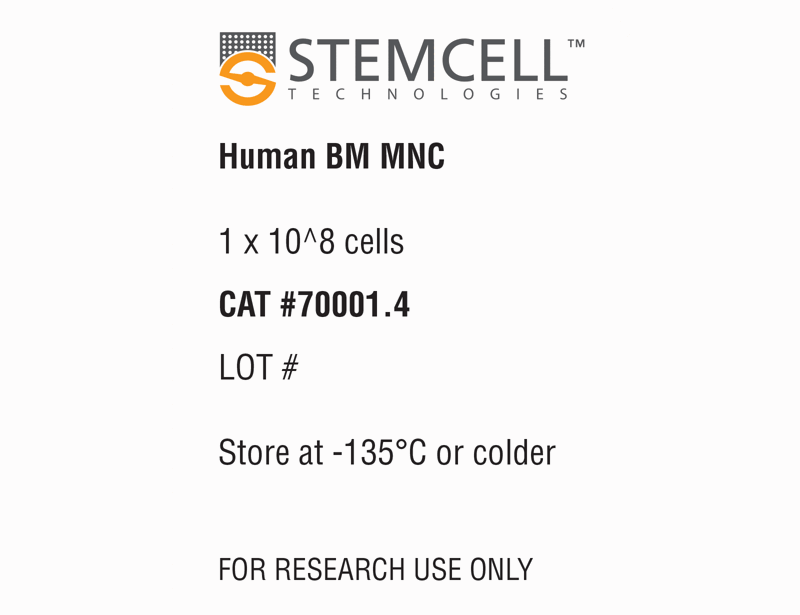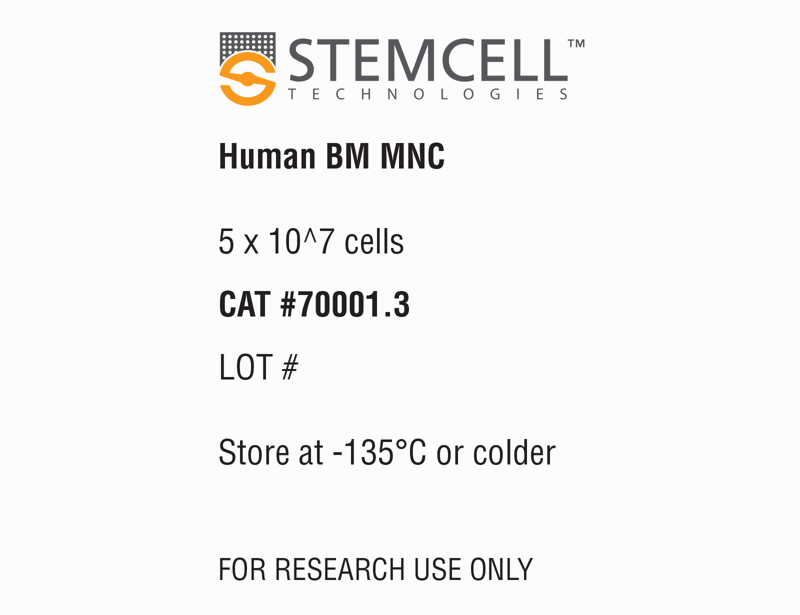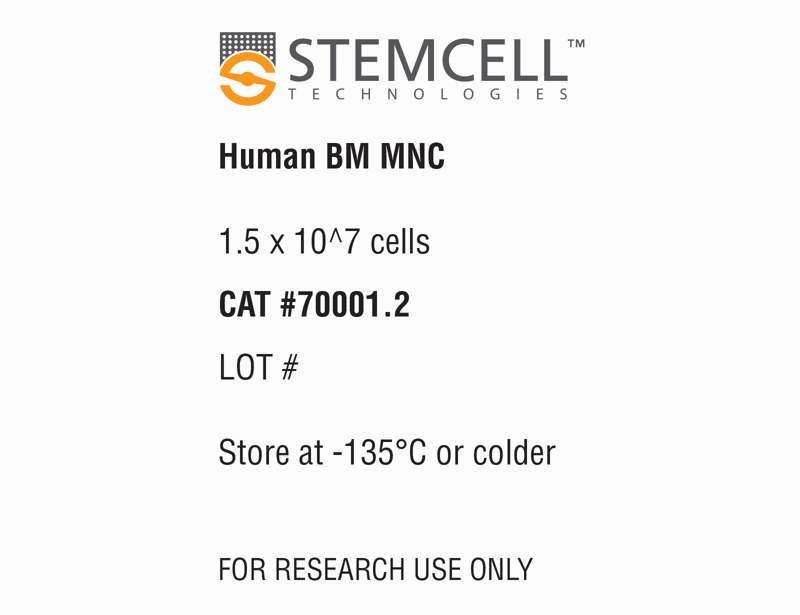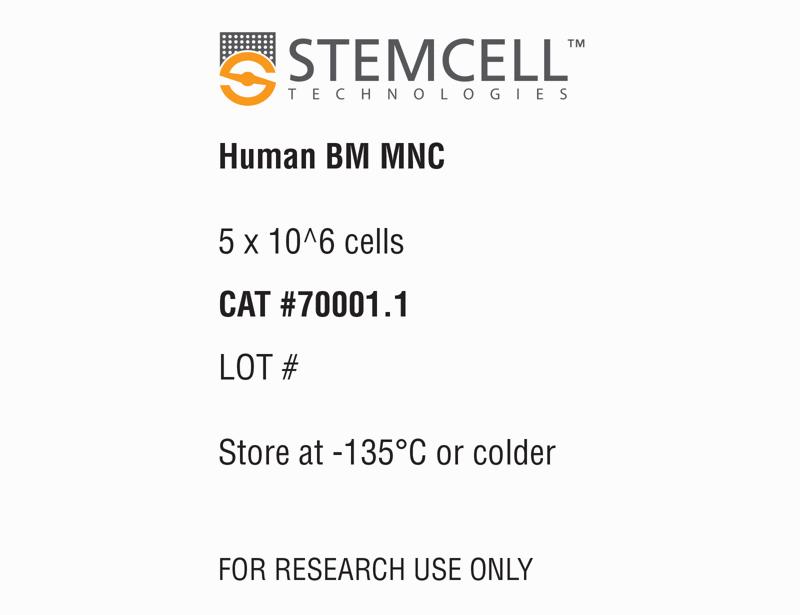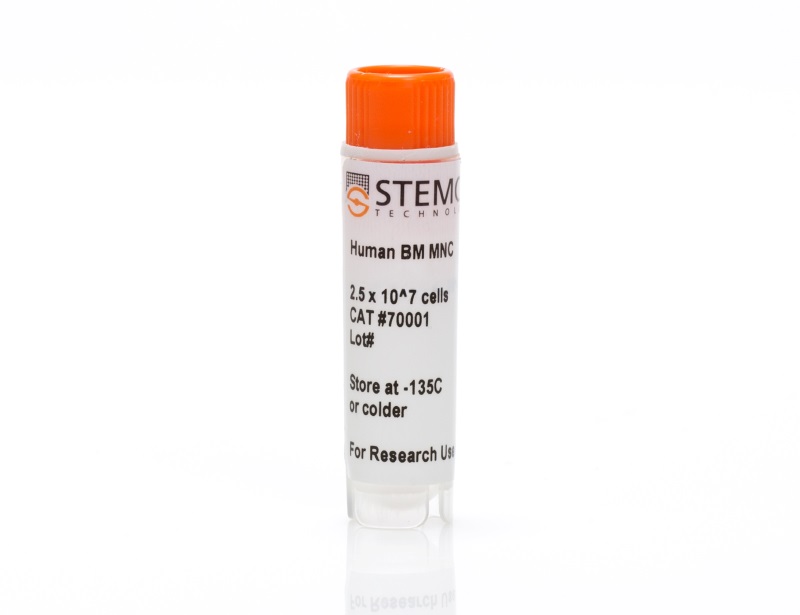Human Bone Marrow Mononuclear Cells, Frozen
Primary human cells, frozen
概要
Primary bone marrow mononuclear cells (a.k.a. BM MNCs or BMNCs) are a heterogeneous population that includes hematopoietic lineage cells such as lymphocytes, monocytes, stem cells, and progenitor cells as well as mesenchymal stromal cells. Mononuclear cells are isolated from human adult bone marrow using density gradient separation. Heparin is added to the bone marrow upon collection as an anticoagulant.
Cells were obtained using Institutional Review Board (IRB) approved consent forms and protocols.
Certain products are only available in select territories. Please contact your local Sales representative or Product & Scientific Support at techsupport@stemcell.com for further information.
Cells were obtained using Institutional Review Board (IRB) approved consent forms and protocols.
Certain products are only available in select territories. Please contact your local Sales representative or Product & Scientific Support at techsupport@stemcell.com for further information.
Contains
• CryoStor® CS10
Subtype
Frozen
Cell Type
Mononuclear Cells
Species
Human
Cell and Tissue Source
Bone Marrow
Donor Status
Normal
技术资料
| Document Type | 产品名称 | Catalog # | Lot # | 语言 |
|---|---|---|---|---|
| Product Information Sheet | Human Bone Marrow Mononuclear Cells, Frozen | 70001, 70001.1, 70001.2, 70001.3, 70001.4 | All | English |
数据及文献
Publications (5)
Nature 2018 FEB
Population snapshots predict early haematopoietic and erythroid hierarchies.
Abstract
Abstract
The formation of red blood cells begins with the differentiation of multipotent haematopoietic progenitors. Reconstructing the steps of this differentiation represents a general challenge in stem-cell biology. Here we used single-cell transcriptomics, fate assays and a theory that allows the prediction of cell fates from population snapshots to demonstrate that mouse haematopoietic progenitors differentiate through a continuous, hierarchical structure into seven blood lineages. We uncovered coupling between the erythroid and the basophil or mast cell fates, a global haematopoietic response to erythroid stress and novel growth factor receptors that regulate erythropoiesis. We defined a flow cytometry sorting strategy to purify early stages of erythroid differentiation, completely isolating classically defined burst-forming and colony-forming progenitors. We also found that the cell cycle is progressively remodelled during erythroid development and during a sharp transcriptional switch that ends the colony-forming progenitor stage and activates terminal differentiation. Our work showcases the utility of linking transcriptomic data to predictive fate models, and provides insights into lineage development in vivo.
Arthritis research & therapy 2015 MAY
Yes-associated protein (YAP) is a negative regulator of chondrogenesis in mesenchymal stem cells.
Abstract
Abstract
INTRODUCTION The control of differentiation of mesenchymal stromal/stem cells (MSCs) is crucial for tissue engineering strategies employing MSCs. The purpose of this study was to investigate whether the transcriptional co-factor Yes-associated protein (YAP) regulates chondrogenic differentiation of MSCs. METHODS Expression of total YAP, its paralogue transcriptional co-activator with PDZ-binding motif (TAZ), and individual YAP transcript variants during in vitro chondrogenesis of human MSCs was determined by quantitative reverse transcription polymerase chain reaction (RT-PCR). YAP expression was confirmed by western blotting. To determine the effect of high YAP activity on chondrogenesis, C3H10T1/2 MSC-like cells were transduced with human (h)YAP and treated in micromass with bone morphogenetic protein-2 (BMP-2). Chondrogenic differentiation was assessed by alcian blue staining and expression of chondrocyte-lineage genes. BMP signalling was determined by detection of pSmad1,5,8 by western blotting and expression of BMP target genes by quantitative RT-PCR. Finally, YAP and pYAP were detected in mouse embryo hindlimbs by immunohistochemistry. RESULTS YAP, but not TAZ, was downregulated during in vitro chondrogenesis of human MSCs. One of the YAP transcript variants, however, was upregulated in high-density micromass culture. Overexpression of hYAP in murine C3H10T1/2 MSCs inhibited chondrogenic differentiation. High YAP activity in these cells decreased Smad1,5,8 phosphorylation and expression of the BMP target genes Inhibitor of DNA binding/differentiation (Id)1, Id2 and Id3 in response to BMP-2. In developing mouse limbs, Yap was nuclear in the perichondrium while mostly phosphorylated and cytosolic in cells of the cartilage anlage, suggesting downregulation of Yap co-transcriptional activity during physiological chondrogenesis in vivo. CONCLUSIONS Our findings indicate that YAP is a negative regulator of chondrogenic differentiation of MSCs. Downregulation of YAP is required for chondrogenesis through derepression of chondrogenic signalling. Therapeutic targeting of YAP to promote cartilage repair and prevent secondary osteoarthritis is an exciting prospect in rheumatology.
International immunopharmacology 2013 MAR
Anti-inflammatory activity of a naphthyridine derivative (7-chloro-6-fluoro-N-(2-hydroxy-3-oxo-1-phenyl-3-(phenylamino)propyl)-4-oxo-1-(prop-2-yn-1-yl)-1,4-dihydro-1,8-naphthyridine-3-carboxamide) possessing in vitro anticancer potential.
Abstract
Abstract
We have previously synthesized a series of 1,8-naphthyridine-3-carboxamide derivatives to identify potential anti-cancer/anti-inflammatory compounds. Three derivatives, 7-chloro-N-(3-(cyclopentylamino)-3-oxo-1-phenylpropyl)-6-fluoro-4-oxo-1-(prop-2-yn-1-yl)-1,4-dihydro-1,8-naphthyridine-3-carboxamide (C-22), 7-chloro-N-(2-hydroxy-3-oxo-1-phenyl-3-(phenylamino)propyl)-4-oxo-1-(prop-2-yn-1-yl)-1,4-dihydro-1,8-naphthyridine-3-carboxamide (C-31) and 7-chloro-6-fluoro-N-(2-hydroxy-3-oxo-1-phenyl-3-(phenylamino)propyl)-4-oxo-1-(prop-2-yn-1-yl)-1,4-dihydro-1,8-naphthyridine-3-carboxamide (C-34) demonstrated high cytotoxicity against a number of cancer cell lines and inhibited secretion of IL-1-β and IL-6. In the present study, C-22, C-31 and C-34 were assessed for modulation of pro-inflammatory cytokines, TNF-α and IL-8, chemokine RANTES and NO produced by lipopolysaccharide (LPS)-treated mouse Dendritic cells (DCs). Among the 3 compounds, C-34 showed the most potent inhibition of inflammatory markers in DC model at 0.2 and 2 μM. C-34 also significantly downregulated the secretion of TNF-α, IL-1-β and IL-6 by murine splenocytes and THP-1 cells against LPS induced levels. In vitro effects of C-34 on bone marrow toxicity were assessed in CFU-GM assay. Human CFU-GM population was comparatively more sensitive to C-34 (0.1-10 μM) than murine CFU-GM. IC50 values for murine and human CFU-GM were not attained. C-34 was further examined for in vivo suppression of LPS induced cytokines in a mice model. At doses ranging from 1.25 to 5 mg/kg, C-34 led to significant inhibition of TNF-α, IL-1-β, IL-6 and MIP-1-α. At the highest dose of 5 mg/kg, C-34 also protected LPS-treated mice against endotoxin-induced lethality. In conclusion, C-34 demonstrates anti-inflammatory activity in vitro and in vivo in addition to cytotoxic properties. This finding suggests its potential for further development as a synthetic naphthyridine derivative with dual anti-cancer and anti-inflammatory (cytokine inhibition) properties.
American heart journal 2011 JUN
A randomized study of transendocardial injection of autologous bone marrow mononuclear cells and cell function analysis in ischemic heart failure (FOCUS-HF).
Abstract
Abstract
BACKGROUND Autologous bone marrow mononuclear cell (ABMMNC) therapy has shown promise in patients with heart failure (HF). Cell function analysis may be important in interpreting trial results. METHODS In this prospective study, we evaluated the safety and efficacy of the transendocardial delivery of ABMMNCs in no-option patients with chronic HF. Efficacy was assessed by maximal myocardial oxygen consumption, single photon emission computed tomography, 2-dimensional echocardiography, and quality-of-life assessment (Minnesota Living with Heart Failure and Short Form 36). We also characterized patients' bone marrow cells by flow cytometry, colony-forming unit, and proliferative assays. RESULTS Cell-treated (n = 20) and control patients (n = 10) were similar at baseline. The procedure was safe; adverse events were similar in both groups. Canadian Cardiovascular Society angina score improved significantly (P = .001) in cell-treated patients, but function was not affected. Quality-of-life scores improved significantly at 6 months (P = .009 Minnesota Living with Heart Failure and P = .002 physical component of Short Form 36) over baseline in cell-treated but not control patients. Single photon emission computed tomography data suggested a trend toward improved perfusion in cell-treated patients. The proportion of fixed defects significantly increased in control (P = .02) but not in treated patients (P = .16). Function of patients' bone marrow mononuclear cells was severely impaired. Stratifying cell results by age showed that younger patients (%60 years) had significantly more mesenchymal progenitor cells (colony-forming unit fibroblasts) than patients<60 years (20.16 ± 14.6 vs 10.92 ± 7.8, P = .04). Furthermore, cell-treated younger patients had significantly improved maximal myocardial oxygen consumption (15 ± 5.8, 18.6 ± 2.7, and 17 ± 3.7 mL/kg per minute at baseline, 3 months, and 6 months, respectively) compared with similarly aged control patients (14.3 ± 2.5, 13.7 ± 3.7, and 14.6 ± 4.7 mL/kg per minute, P = .04). CONCLUSIONS ABMMNC therapy is safe and improves symptoms, quality of life, and possibly perfusion in patients with chronic HF.
Journal of immunotherapy (Hagerstown, Md. : 1997) 2011
An antibody-based multifaceted approach targeting the human transferrin receptor for the treatment of B-cell malignancies.
Abstract
Abstract
We previously developed an antibody-avidin fusion protein (ch128.1Av) targeting the human transferrin receptor 1 (TfR1, also known as CD71), which demonstrates direct in vitro cytotoxicity against malignant hematopoietic cells. This cytotoxicity is attributed to its ability to decrease the level of TfR1 leading to lethal iron deprivation. We now report that ch128.1Av shows the ability to bind the Fcγ receptors and the complement component C1q, suggesting that it is capable of eliciting Fc-mediated effector functions such as antibody-dependent cell-mediated cytotoxicity and complement-mediated cytotoxicity. In addition, in 2 disseminated multiple myeloma xenograft mouse models, we show that a single dose of ch128.1Av results in significant antitumor activity, including long-term survival. It is interesting to note that the parental antibody without avidin (ch128.1) also shows remarkable in vivo anticancer activity despite its limited in vitro cytotoxicity. Finally, we demonstrate that ch128.1Av is not toxic to pluripotent hematopoietic progenitor cells using the long-term cell-initiating culture assay suggesting that these important progenitors would be preserved in different therapeutic approaches, including the in vitro purging of cancer cells for autologous transplantation and in vivo passive immunotherapy. Our results suggest that ch128.1Av and ch128.1 may be effective in the therapy of human multiple myeloma and potentially other hematopoietic malignancies.

